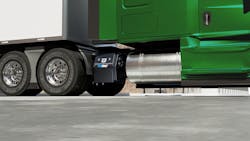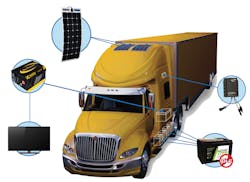Temperatures aren’t the only things that soar in the summer. Fuel prices also rise as demand goes up. Both are good reasons for over-the-road fleets to equip their sleeper cabs with auxiliary power units (APUs).
These optional units power the truck while the engine is off, eliminating the need to idle to keep the cab’s climate comfortable while the driver takes an hours of service break. The APU can either directly draw from the diesel tank or run off stored battery power. The benefits include lower fuel costs, less engine wear and tear, and reduced emissions.
Read more: Latest developments in electric APUsThe alternative, idling, is a costly proposition.
“At current prices of $4 per gallon, a 10-hour rest period comes out to $32,” noted Sean O’Connor, division manager for Go Power Fleet. Go Power provides solar solutions for APUs to improve engine-off energy generation. “However, the cost of idling is more than just the cost of fuel. One hour of idling is estimated to cause roughly 175 miles of engine wear. The related maintenance costs quickly jump into the tens of thousands of dollars.”
That’s not all. OTR trucks in the shop for that extra maintenance keep their drivers from working. APUs take the heat off while allowing cool air and hotel power for other amenities to stream into the cab.
“Driver retention is such a hot topic, so that’s another big reason why a lot of fleets are choosing to go with the APU as well,” offered Kyle Westermann, Thermo King product service manager for TriPac, the company’s APU solution.
There’s a lot to like about APUs, but they also require some tender loving care.
“Just like any other mechanical system, that maintenance-saving APU itself needs some care and service to keep it performing reliably for the long haul,” said Ryan Rubly, Carrier Transicold’s product manager for alternative power.
Like diesel engines, diesel APUs have aftertreatment systems. Electric APUs don’t, but lithium-ion batteries should be managed appropriately. Recent innovations from manufacturers have addressed these issues and more.
Diesel APU maintenance
The first thing to remember is that diesel APUs do have regular PMs just like any mechanical system.
“At a service interval of 1,000 hours, Carrier Transicold recommends checking coolant and oil levels, inspecting belts, hoses, and air filters among other visual assessments of its diesel APU system components,” Rubly said. “At 2,000 hours, which might equate to a year’s service in many instances, the engine oil and oil filter, air filter, and fuel filter should be changed along with the cabin air filter. Other system inspections are recommended, such as the air conditioning system and heater.”
He also noted that because of where the APU is mounted (usually on the passenger side on the back of the tractor), grime, dirt, and salt can build up, so annual cleaning of the radiator and condenser coils will prevent rust and early component failure.
“Just hit it with a garden hose to clean those fins out to ensure adequate airflow through the condenser coil,” suggested Westermann.
The TriPac product manager also said to ensure the evaporator area has adequate airflow during inspections and is not blocked by tools, duffle bags, chains, or whatever else a driver may have packed near the APU.
What’s new with diesel APUs?
One thing truckers hate is to pull over and wait for a forced regeneration cycle of the engine’s aftertreatment system. A diesel APU’s DPF also needs to burn off soot, which, for the TriPac Evolution, requires a driver to maintain highway speeds for 60 to 80 minutes, Westermann explained. If they can’t, the driver would have to manually initiate a forced regen of the APU’s system. If they don’t do that within 10 to 15 hours, the APU would shut down.
With the new 3rd Generation TriPac—which goes into production this month—iterated to meet EPA Tier 4 compliance, Thermo King took the opportunity to completely redesign the aftertreatment system. (This is only available on the 50-state compliant model, not the 49-state compliant version.)
“The advantage of our new system is it requires no driver interaction— it’s completely passive,” Westermann said. “And the time of that regeneration is reduced, on average, down to eight minutes.”
The 3rd-gen TriPac also uses 25% of the fuel per hour that idling would, which Thermo King said saves an average of 2,500 gallons of fuel per year. If diesel costs $3.50 a gallon, an APU-equipped truck would save $8,750 per year.
Both 3rd-gen models have the option to utilize TracKing telematics, which provides fleets with run hours, cabin temperatures, and fuel tax reporting, as well as maintenance alerts and software updates in real time.
Rubly said that if an APU has a fuel-fired heater, it should run for 30 minutes each month. Carrier’s just-released Aspen APU improves upon this by “provid[ing] electric heating via its powerful generator, which eliminates the need for the monthly operational tests required of a fuel-fired heater, as well as the related fuel consumption,” Rubly said.
The Aspen also runs self-diagnostic tests, which take a few minutes and report any problems via fault codes. The control interface also provides fault codes, operating temperature, and voltage data.
“Additionally, the unit keeps tabs on system run-hours, enabling automatic alerts as to when service is due,” Rubly said.
To support the Aspen, Carrier developed CabinTech software, “which provides technicians with comprehensive system insights, including the ability to review diagnostic information, graph real-time run parameters, and configure APU system operating parameters and preferences via connection to a laptop,” Rubly said.
Electric APU maintenance and innovations
Rubly noted that upfitting an electric APU with lithium-ion batteries reduces maintenance needs and improves driver satisfaction. They cost more upfront “but offer significantly longer battery operational time and lifespan,” he added.
AGM batteries, on the other hand, cost less though they “require replacement after three to four years due to degradation of battery performance,” Rubly noted. “If a driver is complaining of short run times with a battery-based APU, the battery is typically the culprit.”
Carrier Transicold’s ComfortPro electric APU also uses an isolator to ensure the truck start batteries don’t degrade due to APU usage, which helps to extend battery life and mitigates potential dead battery callouts on the tractor itself.
According to Go Power, putting solar panels on the cab roof can triple the life of APU batteries.
“Because the solar power is keeping the batteries within the healthy range, they are not sulfating, which means they degrade at a much slower rate than usual,” O’Connor said. “So, the benefits here would be less battery replacement and fewer service calls for jumping dead batteries.”
He added that for diesel APUs, the solar system keeps the main battery at a higher state of charge, which allows the APU motor to run less.
The next question is what kind of maintenance the panels need.
“The panels can be walked on and are tested to withstand 2-inch hailstones fired at 51mph. These kits are rugged and can be expected to last a long time,” O’Connor concluded.
About the Author

John Hitch
Editor-in-chief, Fleet Maintenance
John Hitch is the award-winning editor-in-chief of Fleet Maintenance, where his mission is to provide maintenance leaders and technicians with the the latest information on tools, strategies, and best practices to keep their fleets' commercial vehicles moving.
He is based out of Cleveland, Ohio, and has worked in the B2B journalism space for more than a decade. Hitch was previously senior editor for FleetOwner and before that was technology editor for IndustryWeek and and managing editor of New Equipment Digest.
Hitch graduated from Kent State University and was editor of the student magazine The Burr in 2009.
The former sonar technician served honorably aboard the fast-attack submarine USS Oklahoma City (SSN-723), where he participated in counter-drug ops, an under-ice expedition, and other missions he's not allowed to talk about for several more decades.


